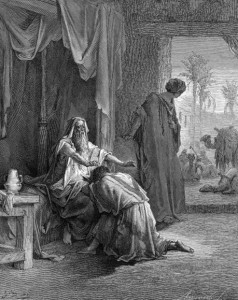What are the 5 key qualities that Mashiach must possess? What is the true role of the Messiah, and how can we properly identify this person? And who were the 5 major figures in Jewish history that had a messianic movement associated with them? Find out in this class, where we also explore Jacob’s transformation into Israel, the spiritual power of music, the greatness of King David, and the timeline of events in the forthcoming Messianic Age.
Tag Archives: Esau
Shevirat haKelim and the Kings of Edom
This week’s parasha, Vayishlach, has an entire chapter outlining the progeny of Esau in detail, along with all the future “kings of Edom” that emerged from him. The inclusion of this passage in the Torah is somewhat puzzling: why should we care to know about all of these foreign rulers? Like we explored last week with Jacob’s sheep, though this information may seem trivial on the surface, mystical texts actually derive a great deal of meaning from this chapter. In fact, the Arizal stated that the secrets of shevirat hakelim, the famous “Shattering of the Vessels” at the start of Creation, are relayed specifically in this chapter.
 Recall that God originally made the cosmos entirely with Gevurah, or Din, with strict measure, strong judgement, and precise severity. This is why the account of Creation uses only Elohim as the name of God, for that is the name associated with Din (whereas the Tetragrammaton is typically associated with Chessed, unlimited kindness, and more specifically, with Rachamim, mercy and compassion). However, that universe was “too perfect” and too fragile, unable to contain God’s light. Of the ten “vessels” (the Sefirot) that held the universe together, the lower seven “shattered” and had to be reconstructed. The Arizal notes that they shattered into 288 major fragments. This is alluded to when the Torah says that the Spirit of God “hovered” over the primordial waters (Genesis 1:2). The word “hovered”, merachefet (מרחפת), is an anagram of met-rapach (מת רפ״ח), the fall or “death” of the 288 pieces (see Sha’ar HaPesukim on Beresheet). Continue reading
Recall that God originally made the cosmos entirely with Gevurah, or Din, with strict measure, strong judgement, and precise severity. This is why the account of Creation uses only Elohim as the name of God, for that is the name associated with Din (whereas the Tetragrammaton is typically associated with Chessed, unlimited kindness, and more specifically, with Rachamim, mercy and compassion). However, that universe was “too perfect” and too fragile, unable to contain God’s light. Of the ten “vessels” (the Sefirot) that held the universe together, the lower seven “shattered” and had to be reconstructed. The Arizal notes that they shattered into 288 major fragments. This is alluded to when the Torah says that the Spirit of God “hovered” over the primordial waters (Genesis 1:2). The word “hovered”, merachefet (מרחפת), is an anagram of met-rapach (מת רפ״ח), the fall or “death” of the 288 pieces (see Sha’ar HaPesukim on Beresheet). Continue reading
The Caesar Who Saved Judaism

“Isaac Blessing Jacob”, by Gustav Doré
This week’s parasha, Toldot, begins with the births of the twins Jacob and Esau. Their mother, Rebecca, felt trouble brewing in her womb, and received prophecy that “two nations are in your womb, and two peoples will emerge from your innards” (Genesis 25:23). Jacob, of course, is the forefather of the Jewish people, while Esau would become the spiritual progenitor of the Roman Empire, and then the entire Christian world as a whole (see ‘How Esau Became Rome’).
The Ba’al haTurim (Rabbi Yaakov ben Asher, c. 1269-1343) comments on the above verse that the words shnei goyim b’vitnekh (שני גוים בבטנך), “two nations are in your womb”, has the same gematria as “this is Rabbi Yehuda and Antoninus” (זה רבי יהודה ואנטונינוס). Recall that Rabbi Yehuda haNasi was the president of Israel in the 2nd century CE, and is credited with composing the Mishnah, the first complete corpus of Jewish law, while Antoninus was a Roman official who was his close friend. The Ba’al haTurim is telling us that there is a profound connection between these two sets of people that are separated by nearly two millennia. What is the connection between the pair of Jacob and Esau, and the pair of Rabbi Yehuda haNasi and Antoninus? Continue reading
